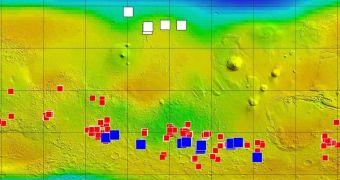NASA officials announced yesterday, August 4, that they have identified seasonal landscape features on the surface of Mars that may be carved by liquid salty water. The discovery goes a long way towards confirming that it may be indeed possible to discover primitive life on our neighboring planet.
Over the past few years, all missions sent to analyze the Red Planet have revealed telltale signs that the landscape was once criss-crossed by rivers, deltas and even an ocean. However, experts could not determine whether the water had long since vanished, or whether it still flows on the surface.
The newest data collected by the American space agency' Mars Reconnaissance Orbiter (MRO) indicates that the latter scenario is true. Needless to say, astronomers were extremely surprised by this discovery, but verified it extensively with follow-up studies.
What the MRO High Resolution Imaging Science Experiment (HiRISE) instrument saw were gully-like structures, which were found to develop on the Martian surface during spring and summer, subside in the winter, and then reappear the following year.
Freshwater cannot endure on the planet due to freezing temperatures, even in the warmest months. However, when salts are added to the mix, the freezing point of water drops dramatically. As such, it is entirely possible that the seasonal features are in fact carved by briny water.
Following the announcement, experts began analyzing the implications of such a finding on our quest to find extraterrestrial life on the Red Planet. With the NASA Mars Science Laboratory (MSL) mission ready to launch later this year, these discoveries couldn't have come at a more appropriate time.
Scientists now say that it is very possible life exists on Mars, even if only in a very primitive form. Here on Earth, microorganisms are known to endure, and even thrive, in even harsher conditions.
“It hasn't been a question for some time now that there's ice on Mars. What makes these new observations so interesting is that they occur at much lower latitudes where temperatures are much warmer and where it's actually possible for liquid water to exist,” Philip Christensen explained.
The Arizona State University (ASU) geophysicist made the announcement during a NASA press conference on Thursday. He explained that astrobiologists are undoubtedly thrilled about the finding.
“I think this is an eye-opening discovery that will really help us begin the planning process for future missions specifically looking for signs of the presence of life on Mars,” Indiana University biogeochemist Lisa Pratt added.
The new discovery provides “our first chance to see an environment on Mars that might allow for the expression of an active biological process if there is presently life on Mars,” the expert goes on to say, quoted by Space.
However, the HiRISE team cautions against becoming overly-enthusiastic about this discovery. They say that the data provide only circumstantial evidence for the existence of liquid water, and that more studies are required in order to confirm the MRO information.

 14 DAY TRIAL //
14 DAY TRIAL //